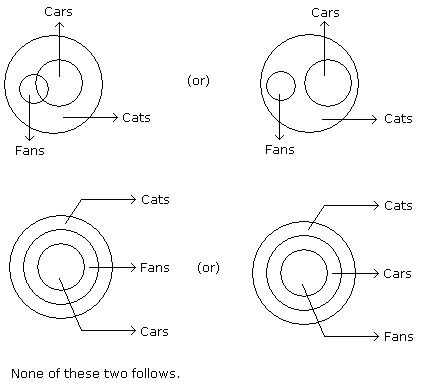Verbal Reasoning - Syllogism - Discussion
Discussion Forum : Syllogism - Syllogism 1 (Q.No. 14)
Directions to Solve
In each of the following questions two statements are given and these statements are followed by two conclusions numbered (1) and (2). You have to take the given two statements to be true even if they seem to be at variance from commonly known facts. Read the conclusions and then decide which of the given conclusions logically follows from the two given statements, disregarding commonly known facts.
Give answer:
- (A) If only (1) conclusion follows
- (B) If only (2) conclusion follows
- (C) If either (1) or (2) follows
- (D) If neither (1) nor (2) follows and
- (E) If both (1) and (2) follow.
14.
Statements: All cars are cats. All fans are cats.
Conclusions:
- All cars are fans.
- Some fans are cars.
Answer: Option
Explanation:

Discussion:
63 comments Page 3 of 7.
Rajesh said:
6 years ago
I think option E is right.
(2)
Divya Tomar said:
6 years ago
I think only the 2nd conclusion follows.
Navneet said:
6 years ago
In case where it can be concluded that " all boys are tall ". Then " some boys are tall " can be considered as a true conclusion or not?
Please tell me.
Please tell me.
(1)
Tien said:
7 years ago
Why not C?
SAMRAT said:
7 years ago
@Sudhanshu.
Conclusion 2 is the correct Answer.
Conclusion 2 is the correct Answer.
Vanisri said:
7 years ago
Both 1 and 2 are correct according to me.
Sandeep said:
7 years ago
From 3rd diagram, both 1 and 2 are right. Then how it could be option D?
Lucky said:
7 years ago
There 4 possible diagrams are there. Which one should we consider? According to the last option, E is right. Please help me to get it.
P. Mahalaxmi said:
7 years ago
According to the third diagram option (E) is correct.
Deepjit das said:
8 years ago
The 2nd sentence is All fans are cats. If you reverse it will be 'some cats are fans'.
Now we get.
All cars are cats. Some cats are fans.
According to the rules all + some make no conclusion.
So the answer is D.
Now we get.
All cars are cats. Some cats are fans.
According to the rules all + some make no conclusion.
So the answer is D.
Post your comments here:
Quick links
Quantitative Aptitude
Verbal (English)
Reasoning
Programming
Interview
Placement Papers